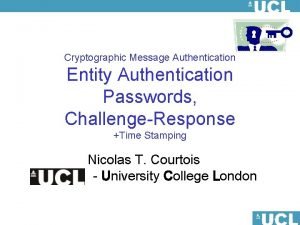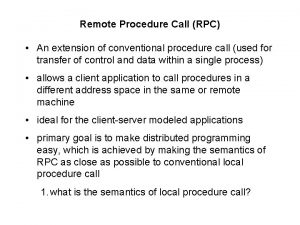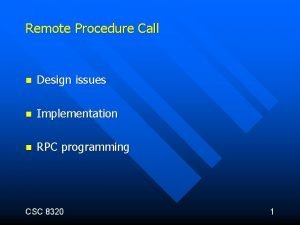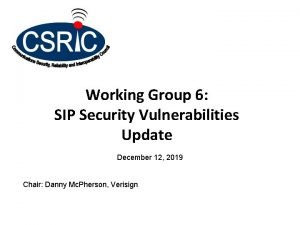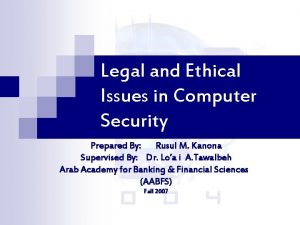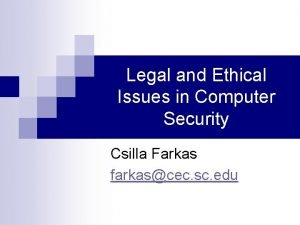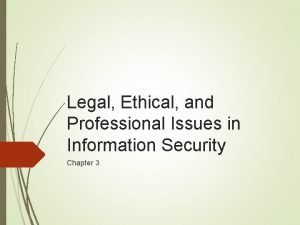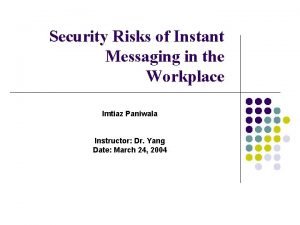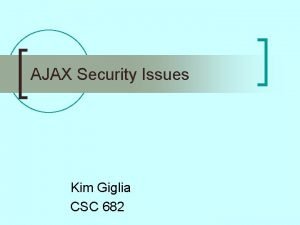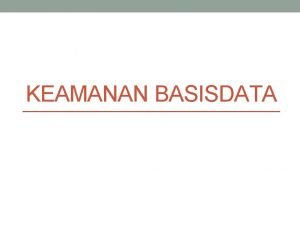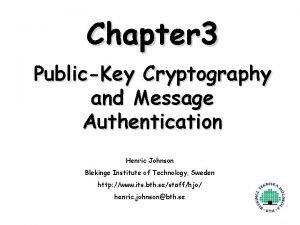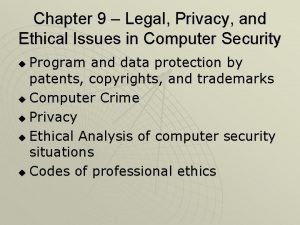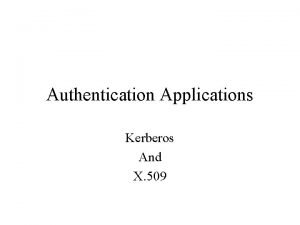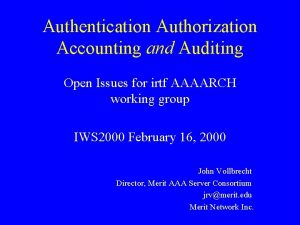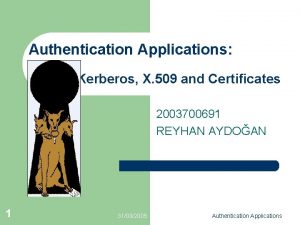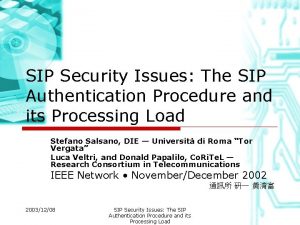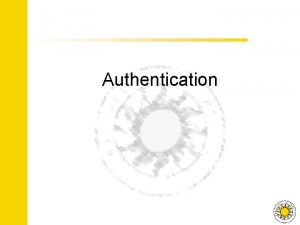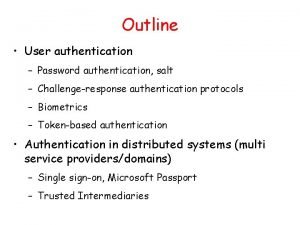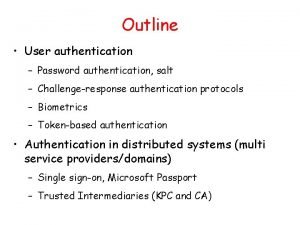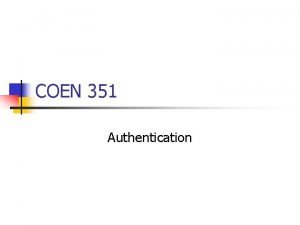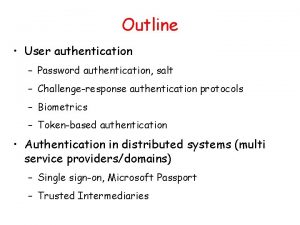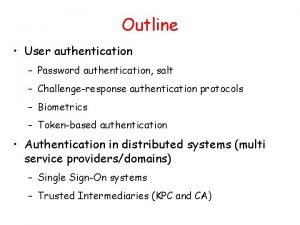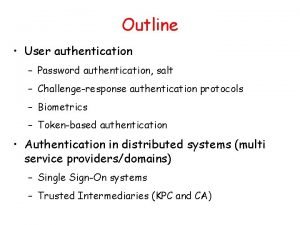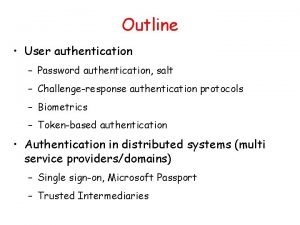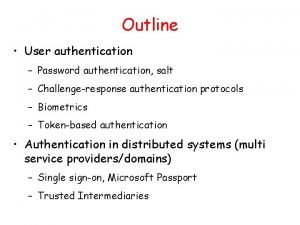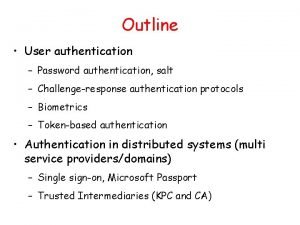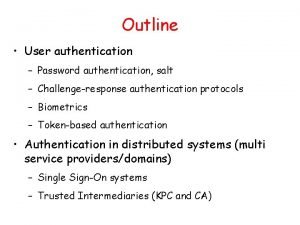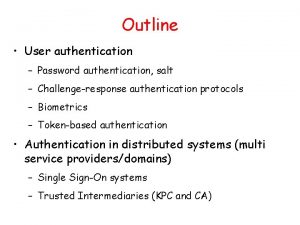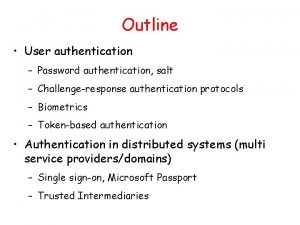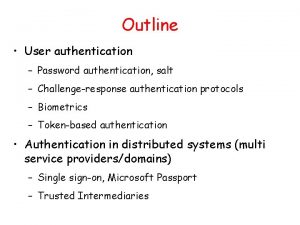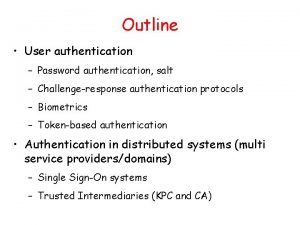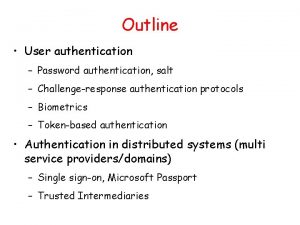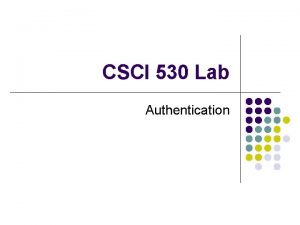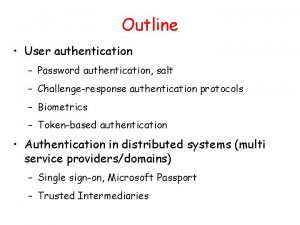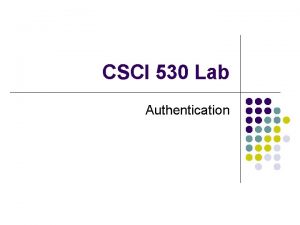SIP Security Issues The SIP Authentication Procedure and


















































![Reference [1] S. Kent and R. Atkinson, “On Applying SIP Security to Networked Appliances, Reference [1] S. Kent and R. Atkinson, “On Applying SIP Security to Networked Appliances,](https://slidetodoc.com/presentation_image_h2/3c284dbbdcaa05f70b87fb64b277de3c/image-51.jpg)
- Slides: 51

SIP Security Issues: The SIP Authentication Procedure and its Processing Load Adviser : Kai-Wei Ke Student : 馮文志 Date : 2006/03/21

Outline ¡ ¡ ¡ ¡ Introduction different types of attack Methods Possible Counter-Measures Security Mechanisms in SIP The Authentication Procedure in SIP An Example Scenario of a SIP-Based IP Telephony Service Methodology for the Evaluation of Processing Cost and Experimental Results Conclusions

Introduction Session Initiation Protocol becoming a real competitor to plain old telephone service. SIP, has been focused on the possibility of providing new dynamic and powerful services Less attention has been paid to security features SIP is a text-based client-server protocol, so SIP communications are susceptible to several types of attacks , Security will be a major concern in such a system Several attack methods can be a real danger to voice services

different types of attack Methods(1/4) ¡ Simplest Attack Management vulnerability e. g. , Spam, eavesdrop. ¡ Modification Attack signaling flow vulnerability e. g. , hijacking, spoof. ¡ serious consequence Attack implementation vulnerability e. g. , Denial of Service.

different types of attack Methods(2/4) ¡ Network Layer

different types of attack Methods(3/4) ¡ Transport Layer

different types of attack Methods(4/4) ¡ Application Layer

precautionary measures ¡ Methodology


Security Mechanisms in SIP(1/7) ¡ Different types of entities are difined SIP User Agent Client (UAC) User Agent Sever (UAS) Proxy Sever Redirect servers Register sever

Security Mechanisms in SIP(2/7) ¡ Securing SIP header and body information can be motivated by two different reasons: ◎Maintain private user and network information in order to guarantee a certain level of privacy. ◎Avoiding SIP Sessions being set up or Changed by someone faking the identity of someone.

Security Mechanisms in SIP(3/7) ¡ The mechanisms that provide security in SIP can be classified as end-to-end or hop-to-hop protection End-to-end:End-to-end mechanisms involve caller and/or callee SIP user agents and are realized by features of the SIP protocol specifically designed for this purpose( e. g. , SIP authentication and SIP msg. body encryption). Hop-by-hop: Hop-by-hop mechanisms secure the communication between two successive SIP entities in the path of signaling messages.

Security Mechanisms in SIP(4/7) ¡ Two main security mechanisms are used with SIP: authentication data encryption

Security Mechanisms in SIP(5/7) ¡ Data authentication: ●authenticate the sender of the message ●ensure that some critical message information was unmodified in transit. ● prevent an attacker from modifying and/or replaying SIP requests and responses.

Security Mechanisms in SIP(6/7) Data encryption: ●ensure confidentiality of SIP communications ●letting only the intended recipient decrypt and read the data. usually done using encryption algorithms such as Data Encryption Standard (DES) and Advanced Encryption Standard (AES) ¡ ¡ SIP supports two forms of encryption: end-to-end and hop-by-hop.

Security Mechanisms in SIP(7/7) ● End-to-end encryption provides confidentially for all information that does not need to be read by intermediate entities. End-to-end encryption is performed by S/MIME mechanisms。 ● hop-by-hop encryption of whole SIP messages can be used in order to protect the information that should be accessed by intermediate entities, such us From, To, and Via headers. Hop-by-hop encryption can be performed by security mechanisms external to SIP (IPSec or TLS).

IPSec mechanism in SIP(1/2) ¡ IPSec is a network layer mechanism that can be used to introduce security directly at the IP layer. ¡ IPSec can be used in SIP mainly between SIP entities that have a preconfigured security association e. g. , servers within the same IP telephony provider.


TLS mechanism in SIP (1/3) ¡ TLS provides transport-layer security over connection-oriented protocols (TCP). ¡ suited to architectures in which hop-byhop security is required between hosts with a more dynamic security association. ¡ user agent uses IPSec or TLS to send SIP requests to a proxy server this does not guarantee that secure transport will be used on the rest of the end-to-end path.

TLS mechanism in SIP(2/3) w The address of a user is normally defined in SIP using a SIP uniform resource identifier (URI) in the form of sip: bob@biloxi. com. w If a user address is expressed using a new type of URI, a SIP Secure (SIPS) URI (sips: bob@biloxi. com), it means that the use of TLS is requested.

Security Mechanisms in SIP: TLS mechanism in SIP(3/3) w TLS security mechanisms can be combined properly to obtain a trusted network scenario. Figure 1 An example of a trusted network scenario

Some limitations in the scope of the mechanisms(1/2) w w First, the integrity mechanisms in Digest do not work very well for SIP. ◎it offers protection only for some SIP parameters Second, Digest requires that a preexisting secure association can be used in SIP servers where the user is pre-configured. e. g. , use of the S/MIME mechanism, lacks an infrastructure for user public key exchange

Some limitations in the scope of the mechanisms(2/2) w ◎ can result in very large messages. Finally, regarding the use of TLS, does not run over UDP and may require maintaining many simultaneous longlived TLS-over-TCP connections. ◎TLS only allows SIP entities to authenticate servers to which they are adjacent.

Some important Security issue(1/4) w important issue currently under focus is the problem of the agreement on the selected security mechanism between two SIP entities (user agents and/or proxies) SIP has a number of possible security solutions, some of them directly defined by SIP and others derived by lower protocols (TLS, IPSec, etc. ). l identity information claimed by the user is not checked in basic SIP operation. l

Some important Security issue(2/4) w w IP telephony server could need to ensure the identity of a user in order to provide a specific service and/or to condition the type of service to the user’s identity itself. very important to define how a SIP entity can select an appropriate mechanism when communicating with a next hop entity.

Some important Security issue(3/4) ◎ SIP authentication model could be one way to obtain such identity ○ user agents do not always have the necessary key information to authenticate with all other agents. ○ A model is proposed for “asserted identity” based on the concept of a “trusted domain. ” ○ The idea is that when a user agent authenticates its own identity with a server, the server may share this authenticated identity (the asserted identity) with all other servers in a trusted domain.

Some important Security issue(4/4) ○ A trusted domain is a set of servers that have a mutual preconfigured security association setup. ○ Such security associations represent the trust between the servers. When a server in a trusted domain authenticates the identity of the originator of a message, it adds a new header to the message containing the asserted identity of the user. ○ Such an identity can be used by all other servers belonging to the same trusted domain and then removed (for preserving user privacy) upon exiting such a domain.

The Authentication Procedure in SIP(1/5) w authentication mechanism in SIP ◎only to user-to-user or user-to-proxy communications ◎proxy-to-proxy authentication should rely on other mechanisms like IPSec or TLS. ◎SIP authentication procedure is derived from HTTP Digest authentication ◎It is a challenge-based mechanism

The Authentication Procedure in SIP(2/5) Figure 2 Digest authentication

The Authentication Procedure in SIP(3/5) Figure 3. SIP “Basic” call setup procedure

The Authentication Procedure in SIP(4/5) Figure 4. SIP call setup with proxy and authentication (stateless proxies)

The Authentication Procedure in SIP(5/5) ●original definition of SIP also allowed a procedure based on ◎HTTP basic authentication. ◎username and password are sent in the clear. ◎subject to packet snooping and not secure at all. ◎The current SIP specification has deprecated this procedure. ●SIP Specification only digest authentication has to be used. ◎digest authentication does not provide a very high level of security by modern security standards. ◎based on a shared secret rather than a public key mechanism. ●SIP protocol also foresees the use of these more secure mechanisms. In particular, described the use of PGP, which could be used a third option (besides basic and digest) in the authentication procedure. ◎The SIP specification also deprecates the use of PGP ◎specifies the use of S/MIME

An Example Scenario of a SIP-Based IP Telephony Service(1/2) w w possible scenario for a SIP-based telephony service in order to analyze the security implications. The service allows users connected to an ISP to place calls in the PSTN. ISP actually uses an ITSP, which provides the gateway and delivers calls to the PSTN. This scenario has the advantage that the ISP already has a security relationship with its customer.

An Example Scenario of a SIP-Based IP Telephony Service(2/2) Figure 5. PC-to-phone call.

Methodology for the Evaluation of Processing Cost and Experimental Results(1/5) ¡ In order to experiment with advanced features in SIP, an open source Java SIP server and realized a testbed within Co. Ri. Te. L laboratory. testbed consists: 1. Linux or Windows 98/2000 OS. 2. SIP client (UAC) 3. SIP server (UAS) 4. differentiated services (Diff. Serv) routers 5. Diff. Serv bandwidth broker. Figure 5 shows the layout of the testbed.

Methodology for the Evaluation of Processing Cost and Experimental Results(2/5) Figure 6. The complete QSIP testbed secnario

Methodology for the Evaluation of Processing Cost and Experimental Results(3/5) ¡ The goal of this testbed was twofold: ◎first, verification of the functional behavior of the various elements and their interoperability. ◎second, the possibility of making some performance analysis. In particular regarding performance analysis,

Methodology for the Evaluation of Processing Cost and Experimental Results(4/5) ¡ an interesting point is the evaluation of the cost to be paid in terms of performance for the introduction of security mechanisms in SIP. e. g. , like the authentication procedure ¡ ¡ followed a pure experimental approach, trying to evaluate the processing costs of different procedures in the elements of this testbed results can be severely dependent on the specific characteristics of the implemented modules and the testbed.

Methodology for the Evaluation of Processing Cost and Experimental Results(5/5) ¡ found it useful to have a first estimate of the relative costs of different procedures in the implementation. In particular, we focused on the SIP proxy servers. defined a methodology to evaluate the processing cost of SIP procedures in the proxy server. measure the maximum performance (throughput in terms of procedures per time unit) the proxy server can achieve. ¡ processing cost of the procedure is derived in inverse proportion to the performance. ¡

Methodology for the Evaluation of Processing Cost and Experimental Results: test environment(1/4) ¡ Figure 6 shows the test environment used to test the performance of the proxy server. complete testbed scenario shown in Fig. 6 Figure 7. Testing SIP server performances.

Methodology for the Evaluation of Processing Cost and Experimental Results: test environment(2/4) ¡ ¡ ¡ all the functionality and components related to Qo. S have been removed. The “tester” UAC on the left is a multithreaded Java application that generates SIP calls and evaluates call throughput. proxy server under test performs the “real” processing of the call, while the “tester” UAS is a simple Java application that gives predefined answers according to the correct SIP message flow.

Methodology for the Evaluation of Processing Cost and Experimental Results: test environment(3/4) Each of the three elements runs in separate PCs (300 MHz Pentium/128 Mbytes RAM, where no other applications are running). ¡ three PCs are connected to a dedicated Fast Ethernet switch. ¡ Each thread in the tester UAC (up to 6) generates a bunch of SIP calls, one after the other. ¡

Methodology for the Evaluation of Processing Cost and Experimental Results: test environment(4/4) ¡ The goal is to saturate the processing capability of the server and measure its maximum throughput. ¡ eight procedures/scenarios have been considered in order to compare their processing cost. As reported in Tables 1 and 2.

Methodology for the Evaluation of Processing Cost and Experimental Results: Experimental Results(1/6) NO authentication, stateless server, UDP (“Basic” call setup procedure)

Methodology for the Evaluation of Processing Cost and Experimental Results: Experimental Results(2/6) ¡ Table 1 reports the call throughput for the procedure/scenario (1) for different numbers of active threads. ¡ Starting from two threads in parallel, the capacity of the server is saturated: each of the N threads takes 1/N of the server capacity, so its throughput is 1/N of the maximum throughput to be evaluated.

Methodology for the Evaluation of Processing Cost and Experimental Results: Experimental Results(3/6)

Methodology for the Evaluation of Processing Cost and Experimental Results: Experimental Results(4/6) ◎the performance dependence on the number of pending authentication states or active call states (5– 8) has been studied. ◎Thanks to the fact that an hash function has been used in the implementation to operate with authentication and call states for the lookup, insert and delete operations,

Methodology for the Evaluation of Processing Cost and Experimental Results: Experimental Results(5/6) The results show that the introduction of SIP security accounts for nearly 80 percent of processing cost of a stateless server and 45 percent of a call stateful server. ¡ This increase can be explained with the increase in the number of exchanged SIP messages and with the actual processing cost of security (including the cryptographic algorithms). ¡

Methodology for the Evaluation of Processing Cost and Experimental Results: Experimental Results(6/6) ¡ have estimated that 70 percent of the additional cost is for message processing and 30 percent for actual security mechanisms. ¡ Another interesting finding is that the TCP processing introduces a small increase with respect to UDP and that the additional increase due to TLS is almost negligible. ◎TCP and TLS connections are already established and available when SIP messages need to be sent. ◎where a relatively stable connection can be assumed between the ISP and ITSP proxy servers. ◎result cannot be extended in general to the use of TSL between arbitrary SIP entities.

Conclusions ¡ ¡ In this article the main security aspects related to SIP-based IP telephony are discussed. authentication procedure, based on HTTP Digest authentication, mapping of authentication mechanisms into a possible SIP-based service scenario are provided performance aspects of SIP authentication are considered with a pure experimental approach processing costs of different security procedures/scenarios are compared under a reference implementation.
![Reference 1 S Kent and R Atkinson On Applying SIP Security to Networked Appliances Reference [1] S. Kent and R. Atkinson, “On Applying SIP Security to Networked Appliances,](https://slidetodoc.com/presentation_image_h2/3c284dbbdcaa05f70b87fb64b277de3c/image-51.jpg)
Reference [1] S. Kent and R. Atkinson, “On Applying SIP Security to Networked Appliances, ” IEEE , Nov. 2004. [2] E. T. Aire and L. P. Linde, “Implemention Considerations in a SIP based secure Voice over IP Network, ” IEEE , Dec. 2004. [3] 網路通訊雜誌社,『網路通訊』,174期 2006 01 月號,南訊出版社。 [4] Http: //www. ebmag. com. tw
 Security services x.800
Security services x.800 Iff
Iff Sip security issues
Sip security issues Authentication in cryptography and network security
Authentication in cryptography and network security Private securit
Private securit Message authentication code requirements
Message authentication code requirements System.security.authentication
System.security.authentication E commerce security and fraud issues and protections
E commerce security and fraud issues and protections Conventional procedure call
Conventional procedure call Design issues of rpc
Design issues of rpc Sip security vulnerabilities
Sip security vulnerabilities Sip security best practice
Sip security best practice Legal ethical and societal issues in media and information
Legal ethical and societal issues in media and information Legal and ethical issues in computer security
Legal and ethical issues in computer security Attack sophistication vs intruder technical knowledge
Attack sophistication vs intruder technical knowledge Legal and ethical issues in information security
Legal and ethical issues in information security Instant messaging security issues
Instant messaging security issues Ajax security issues
Ajax security issues Software security issues
Software security issues Why database security is important
Why database security is important Wireless security in cryptography
Wireless security in cryptography Security policy and integrated security in e-commerce
Security policy and integrated security in e-commerce Approaches to message authentication
Approaches to message authentication Kerberos version 4 authentication dialogue
Kerberos version 4 authentication dialogue Differences between law and ethics
Differences between law and ethics Kerberos motivation
Kerberos motivation Authentication filters in mvc 5
Authentication filters in mvc 5 Authentication authorization auditing
Authentication authorization auditing Authentication and authorization infrastructure
Authentication and authorization infrastructure Authentication applications kerberos and x.509
Authentication applications kerberos and x.509 Hình ảnh bộ gõ cơ thể búng tay
Hình ảnh bộ gõ cơ thể búng tay Lp html
Lp html Bổ thể
Bổ thể Tỉ lệ cơ thể trẻ em
Tỉ lệ cơ thể trẻ em Voi kéo gỗ như thế nào
Voi kéo gỗ như thế nào Tư thế worms-breton
Tư thế worms-breton Bài hát chúa yêu trần thế alleluia
Bài hát chúa yêu trần thế alleluia Môn thể thao bắt đầu bằng từ đua
Môn thể thao bắt đầu bằng từ đua Thế nào là hệ số cao nhất
Thế nào là hệ số cao nhất Các châu lục và đại dương trên thế giới
Các châu lục và đại dương trên thế giới Công thức tính độ biến thiên đông lượng
Công thức tính độ biến thiên đông lượng Trời xanh đây là của chúng ta thể thơ
Trời xanh đây là của chúng ta thể thơ Mật thư tọa độ 5x5
Mật thư tọa độ 5x5 101012 bằng
101012 bằng Phản ứng thế ankan
Phản ứng thế ankan Các châu lục và đại dương trên thế giới
Các châu lục và đại dương trên thế giới Thơ thất ngôn tứ tuyệt đường luật
Thơ thất ngôn tứ tuyệt đường luật Quá trình desamine hóa có thể tạo ra
Quá trình desamine hóa có thể tạo ra Một số thể thơ truyền thống
Một số thể thơ truyền thống Cái miệng nó xinh thế chỉ nói điều hay thôi
Cái miệng nó xinh thế chỉ nói điều hay thôi Vẽ hình chiếu vuông góc của vật thể sau
Vẽ hình chiếu vuông góc của vật thể sau Nguyên nhân của sự mỏi cơ sinh 8
Nguyên nhân của sự mỏi cơ sinh 8

